Mesh compensation results backwards
-
Can you post a photo of your displayed heightmap?
Your config looks ok for your description of the endstop placement etc.
-
@phaedrux
I need to redo it as I have it all reversed now and didn't save the previous, but you can see here the X & Y are reversed from what I got from the original mesh compensation. I ran it twice with about the same results.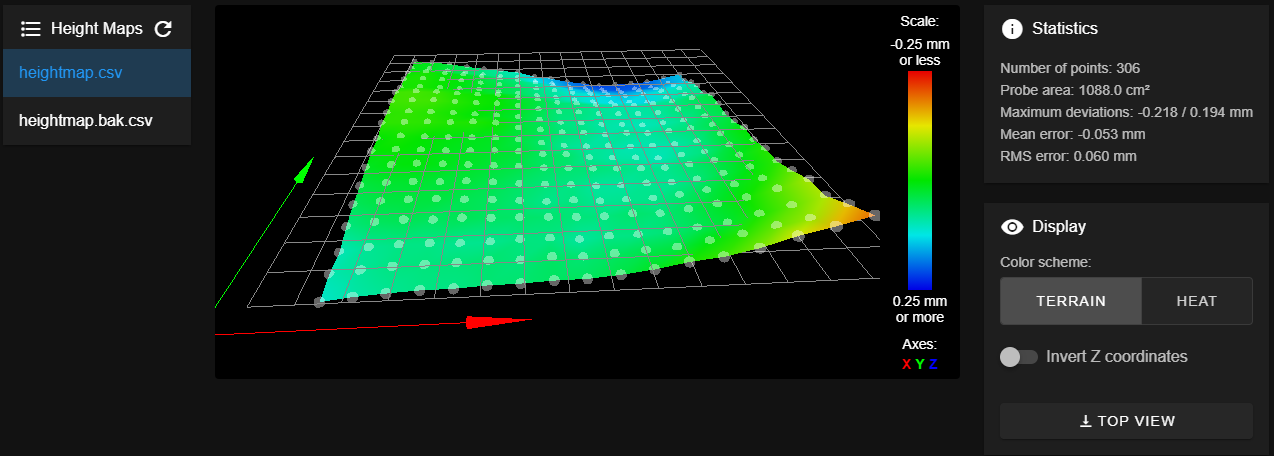
heightmap.csv
RepRapFirmware height map file v2 generated at 2021-08-20 12:08, min error -0.249, max error 0.161, mean -0.028, deviation 0.067 axis0,axis1,min0,max0,min1,max1,radius,spacing0,spacing1,num0,num1 X,Y,10.00,370.00,20.00,320.00,-1.00,20.00,20.00,19,18 0,0,-0.109,-0.091,-0.08,-0.072,-0.071,-0.062,-0.06,-0.052,-0.051,-0.038,-0.018,0.012,0.03,0.065,0.115,0.152,0.194 0,0,-0.095,-0.082,-0.07,-0.067,-0.065,-0.06,-0.066,-0.054,-0.062,-0.052,-0.042,-0.034,-0.007,0.02,0.055,0.084,0.147 0,0,-0.099,-0.08,-0.072,-0.072,-0.078,-0.077,-0.069,-0.07,-0.085,-0.073,-0.071,-0.063,-0.047,-0.027,0.014,0.051,0.095 0,0,-0.069,-0.051,-0.044,-0.051,-0.046,-0.053,-0.056,-0.06,-0.065,-0.068,-0.058,-0.064,-0.046,-0.023,0.005,0.045,0.089 0,0,-0.048,-0.036,-0.033,-0.034,-0.044,-0.05,-0.061,-0.074,-0.069,-0.08,-0.078,-0.076,-0.061,-0.04,-0.015,0.012,0.053 0,0,-0.035,-0.026,-0.024,-0.031,-0.031,-0.042,-0.055,-0.065,-0.071,-0.085,-0.086,-0.078,-0.079,-0.065,-0.037,-0.007,0.023 0,0,-0.018,-0.007,-0.004,-0.013,-0.021,-0.03,-0.039,-0.053,-0.06,-0.065,-0.07,-0.076,-0.077,-0.061,-0.042,-0.016,0.019 0,0,-0.001,0.003,-0.004,-0.013,-0.017,-0.022,-0.03,-0.051,-0.056,-0.079,-0.088,-0.09,-0.099,-0.082,-0.068,-0.031,-0.003 0,0,-0.001,0.01,0.001,-0.007,-0.013,-0.018,-0.035,-0.056,-0.078,-0.086,-0.086,-0.097,-0.095,-0.09,-0.073,-0.033,0.002 0,0,0.024,0.025,0.023,0.016,0.016,0.006,-0.029,-0.044,-0.064,-0.071,-0.088,-0.08,-0.086,-0.074,-0.063,-0.043,-0.026 0,0,0.023,0.026,0.02,0.01,-0.003,-0.013,-0.027,-0.047,-0.069,-0.075,-0.089,-0.094,-0.101,-0.092,-0.078,-0.054,-0.04 0,0,0.033,0.036,0.034,0.02,0.009,0.002,-0.017,-0.04,-0.064,-0.068,-0.081,-0.086,-0.089,-0.085,-0.066,-0.056,-0.034 0,0,0.035,0.036,0.029,0.014,0.005,0.001,-0.023,-0.036,-0.061,-0.068,-0.081,-0.09,-0.093,-0.083,-0.074,-0.053,-0.033 0,0,0.01,0.012,0.003,-0.009,-0.017,-0.036,-0.05,-0.067,-0.084,-0.103,-0.12,-0.129,-0.128,-0.133,-0.105,-0.084,-0.074 0,0,0.013,0.014,0.004,-0.006,-0.025,-0.039,-0.053,-0.073,-0.089,-0.11,-0.119,-0.132,-0.142,-0.131,-0.111,-0.097,-0.081 0,0,0.005,0.011,-0.004,-0.015,-0.031,-0.051,-0.065,-0.085,-0.108,-0.135,-0.15,-0.163,-0.171,-0.159,-0.15,-0.13,-0.103 0,0,-0.009,-0.016,-0.035,-0.05,-0.066,-0.081,-0.092,-0.125,-0.144,-0.171,-0.187,-0.2,-0.204,-0.199,-0.191,-0.162,-0.144 0,0,-0.006,-0.017,-0.03,-0.053,-0.07,-0.087,-0.102,-0.136,-0.154,-0.181,-0.199,-0.218,-0.212,-0.207,-0.198,-0.17,-0.144 -
First off you should update to firmware version 3.3.
Why are you using M98 to invoke things like homex.g?
There are commands to do that.
For example:
- G28 X will invoke homex.g
- G28 Y will invoke homey.g
- G28 Z will invoke homez.g
- G28 will invoke homeall.g
-
I am running v3.3, eagerly awaiting a stable 3.4 with the accelerometer.

I don't recall why I used M98, but I think it was due to an issue with calling G28 a few versions ago and never changed it back. -
@phaedrux
After validating my tool heights and re-running my meshcompensation macro here is the output: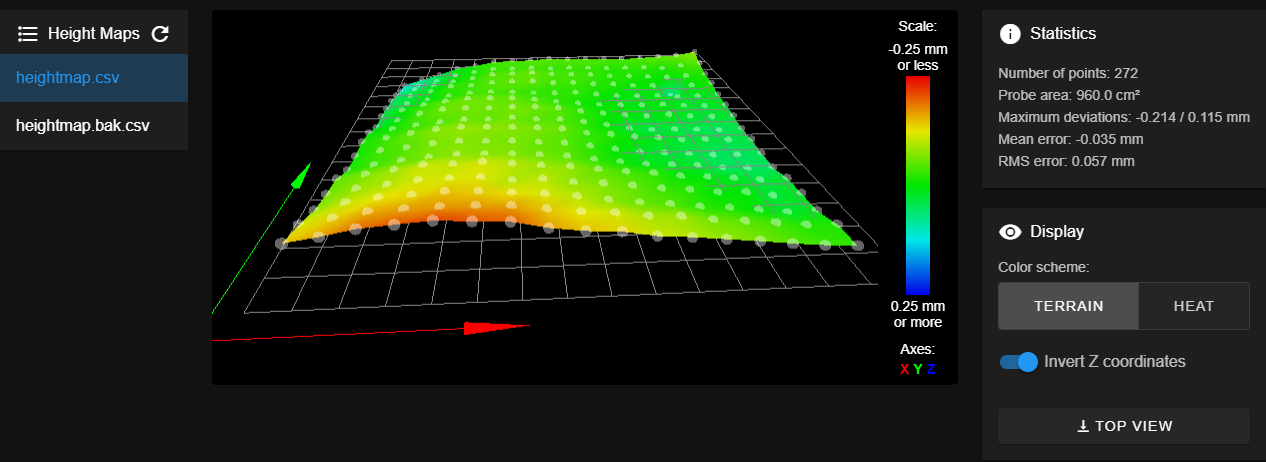
heightmap.csv
RepRapFirmware height map file v2 generated at 2021-08-20 14:48, min error -0.214, max error 0.115, mean -0.035, deviation 0.057 axis0,axis1,min0,max0,min1,max1,radius,spacing0,spacing1,num0,num1 X,Y,10.00,370.00,20.00,320.00,-1.00,20.00,20.00,19,16 0, 0, -0.141, -0.163, -0.191, -0.203, -0.214, -0.205, -0.197, -0.164, -0.144, -0.135, -0.108, -0.096, -0.080, -0.064, -0.046, -0.031, -0.023 0, 0, -0.114, -0.137, -0.159, -0.165, -0.169, -0.168, -0.163, -0.143, -0.124, -0.113, -0.092, -0.085, -0.062, -0.050, -0.035, -0.018, -0.016 0, 0, -0.079, -0.109, -0.126, -0.133, -0.145, -0.139, -0.128, -0.117, -0.100, -0.077, -0.058, -0.045, -0.025, -0.013, 0.002, 0.021, 0.015 0, 0, -0.062, -0.083, -0.097, -0.114, -0.118, -0.119, -0.098, -0.101, -0.078, -0.068, -0.052, -0.032, -0.019, 0.000, 0.003, 0.029, 0.018 0, 0, -0.052, -0.068, -0.086, -0.109, -0.105, -0.114, -0.099, -0.085, -0.076, -0.055, -0.038, -0.025, -0.003, 0.006, 0.018, 0.032, 0.023 0, 0, -0.012, -0.034, -0.053, -0.066, -0.076, -0.075, -0.069, -0.061, -0.049, -0.027, -0.008, 0.009, 0.017, 0.025, 0.045, 0.050, 0.049 0, 0, -0.009, -0.035, -0.046, -0.064, -0.072, -0.067, -0.066, -0.054, -0.046, -0.026, -0.002, 0.017, 0.028, 0.036, 0.049, 0.051, 0.045 0, 0, -0.015, -0.031, -0.054, -0.073, -0.081, -0.077, -0.072, -0.065, -0.056, -0.027, -0.016, 0.002, 0.013, 0.027, 0.029, 0.037, 0.036 0, 0, 0.003, -0.013, -0.032, -0.044, -0.057, -0.053, -0.061, -0.047, -0.042, -0.024, -0.002, 0.023, 0.037, 0.035, 0.043, 0.049, 0.040 0, 0, 0.038, 0.003, -0.036, -0.058, -0.062, -0.058, -0.062, -0.059, -0.049, -0.025, -0.008, 0.006, 0.015, 0.008, 0.024, 0.030, 0.025 0, 0, 0.034, 0.003, -0.029, -0.046, -0.059, -0.058, -0.055, -0.042, -0.025, -0.012, 0.001, 0.004, 0.009, 0.009, 0.019, 0.024, 0.017 0, 0, 0.047, 0.023, 0.002, -0.019, -0.035, -0.038, -0.034, -0.025, -0.022, -0.023, -0.009, 0.005, 0.010, 0.011, 0.020, 0.018, 0.010 0, 0, 0.055, 0.030, 0.004, -0.028, -0.030, -0.045, -0.050, -0.049, -0.034, -0.032, -0.021, -0.018, -0.004, -0.001, 0.069, 0.001, -0.011 0, 0, 0.075, 0.045, 0.017, -0.003, -0.022, -0.047, -0.048, -0.054, -0.041, -0.035, -0.031, -0.018, -0.016, -0.008, -0.003, -0.010, -0.019 0, 0, 0.103, 0.072, 0.042, 0.007, -0.014, -0.031, -0.031, -0.036, -0.026, -0.031, -0.026, -0.020, -0.021, -0.022, -0.014, -0.029, -0.045 0, 0, 0.115, 0.078, 0.044, 0.004, -0.012, -0.036, -0.041, -0.043, -0.051, -0.044, -0.046, -0.044, -0.039, -0.043, -0.051, -0.056, -0.079So when I go to print and something is near the 0 side of the X-Axis it gets nice and smooshed against the bed, but moving to the high side of the X-Axis and there is too much gap and I'm losing adhesion. This pattern seems to persist up and down the Y-Axis of the high-side of the X-Axis. This is what leads me to believe my resulting heightmap is coming out backward. When I flipped things around I was getting things to stick, but a bit more than it should.
It seems odd to me that the center area that I home on isn't closer to 0.
Maybe next I'll try turning off mesh compensation and doing a manual check of each corner.
-
@gamefanatic3d said in Mesh compensation results backwards:
I am running v3.3, eagerly awaiting a stable 3.4 with the accelerometer.

Your config.g file lists firmware 3.0 - that threw me off.
With 3.3 the G29 command will invoke the file mesh.g if it exists, which is intended to be used to create the height map needed for mesh compensation.
And the G32 command invokes bed.g which is intended to be used to level the bed using multiple G30 commands.
Since the DWC has both G32 and G29 in it's compensation and calibration pull-down menu, if you want these to work you may want to make use of mesh.g and bed.g.
I don't recall why I used M98, but I think it was due to an issue with calling G28 a few versions ago and never changed it back.
There are some side effects of calling G28 that you don't get when using M98.
One such side effect is marking the axis as un-homed prior to invoking the associated file.
What else it might do I don't know.
But given the importance of actually knowing each axis is homed I suggest you return to using G28.
And you can simply the use of M98 a bit, if desired. M98 P"/sys/some_file.g" is the same as M98 P"some.file.g". When you don't specify a folder it defaults to the system folder, sys.
Frederick
-
There are times when it is important to set the Z=0 datum using a single G30.
This must be done:
- after leveling the bed with G30 commands as you do in your homez.g file
- before creating the height map
- before loading the height map
Whatever XY point you use you must use the same point whenever you set the Z=0 datum.
In your homez.g file you level the bed with a pair of G30 commands and shortly thereafter load the height map using M375 without first setting the Z=0 datum which may have changed as a result of the bed leveling.
-
Based on your feedback I added an additional G30 just after my Z-Axis leveling and before loading the heightmap. Also changed the points at which I am measuring for the left and right to exactly align with the point I am looking for the G30 based on the offsets.
; homez.g ; called to home the Z axis ; G91 ; relative positioning G1 Z5 F6000 H2 ; lift Z relative to current position G90 ; absolute positioning ; Clear height map until we are done. G29 S2 ; Z-Axis probe likely triggers beyond tool height. ; If we have an active tool we need to drop it now. if state.currentTool >= 0 M28 "/sys/tprevious.g" T{state.currentTool} M29 M98 P"/sys/tactive.g" > null ; Delete the register file so we don't try to dock again. M30 "/sys/tactive.g" G1 X190 Y220 F6000 ; go to first probe point G30 ; home Z by probing the bed ;; Points are not related to bed coordinates, but rather probe coordinates. ;; 2 Point G30 P0 X35 Y185.6 Z-9999 ; Left Center G30 P1 X371 Y185.6 Z-9999 S2 ; Right Center G1 X190 Y220 F6000 ; go to first probe point G30 ; home Z by probing the bed ; Load previous tool M98 P"/sys/tprevious.g" M30 "/sys/tprevious.g" ; Load Height Map M375MeshCompensation
;; Heat up bed to common temperature range M140 H0 S70 M190 S70 ; Home the Axis' G28 ; Clear the current height map. G29 S2 ; Define probing grid M557 X10:370 Y20:320 S20 ; Perform Mesh Compensation probing. G29 ; Turn off bed. M140 S0Appreciate the feedback!
Not sure if this is getting after my problem with the results as they are being recorded appear to be reversed in X/Y from what they are being measured... Not sure what else needs to be explored for the automatic mode to work. I'm sure the manual method will!
-
@gamefanatic3d said in Mesh compensation results backwards:
Appreciate the feedback!
Not sure if this is getting after my problem with the results as they are being recorded appear to be reversed in X/Y from what they are being measured... Not sure what else needs to be explored for the automatic mode to work. I'm sure the manual method will!
I would think that if there was some sort of firmware issue that caused the reversal someone would have noticed it by now.
Have you verified that the bed leveling is actually working? One member I worked with had the wiring to the Z steppers reversed and each bed leveling attempt made things worse.
Here is an simplified version of bed leveling that I use which makes use of the programming features of firmware 3.3 to make multiple passes checking the results at the end of each pass.
while true ; run leveling pass ; determine where to probe G30 P0 X-145 Y-65 Z-99999 ; probe near ball stud #1 G30 P1 X0 Y100 Z-99999 ; probe near ball stud #2 G30 P2 X145 Y-65 Z-99999 S3 ; probe near ball stud #3 ; check results - exit loop if results are good if move.calibration.initial.deviation < 0.02 break ; check pass limit - abort if pass limit reached if iterations = 5 M291 P"Bed Leveling Aborted" R"Pass Limit Reached" abort "Bed Leveling Aborted - Pass Limit Reached" ; --- finish up --- ; --- set Z=0 datum which can be affected by leveling --- M98 P"center_probe.g" ; position for probing G30 ; do single probe which sets Z to trigger height of Z probe -
@fcwilt
Thank you for the code. I added your code to my homez.g and it worked the first time every time. I've had bed leveling working for a few years now. I do require that I have two probes to the bed at each point and that they are within 0.005 before accepting the data and that it run no more than 10 times.Here is the output after homing the Z twice.
8/20/2021, 9:54:14 PM Leadscrew adjustments made: 0.061 0.061, points used 2, (mean, deviation) before (0.061, 0.000) after (-0.000, 0.000) 8/20/2021, 9:53:36 PM Leadscrew adjustments made: 0.047 0.073, points used 2, (mean, deviation) before (0.060, 0.008) after (0.000, 0.000)I will also add that in my previous attempt to resolve the problem as noted above I did nothing more than run the meshcompensation macro and tested the results with a print to find the problem, then took the heightmap.csv and brought it into excel to reverse the numbers to get my desired effect. Things were much closer to what they should be (even though not perfect).
So leveling / mesh compensation is working, but I may have something wrong which is causing this issue, but I'm not skilled in memory enough these days to figure out what would have the X and Y coordinates reversed and yet still have everything else working normally. -
A simple way to confirm that the height map is created correctly in regards to left/right would be to create a 4 point height map covering most of the bed.
But before running the process put something a few mm thick (ruler, piece of plastic, etc) on the right side being sure that the two right side probes hit the piece.
This should generate a very tilted height map which, when viewed in the DWC height map viewer, should make it clear if the height map is correct or somehow reversed.
Frederick
-
Well that was a simple trick. I put a small calibration square on the bed to the right side and it quickly polled it. Definitely showing it on the correct side.
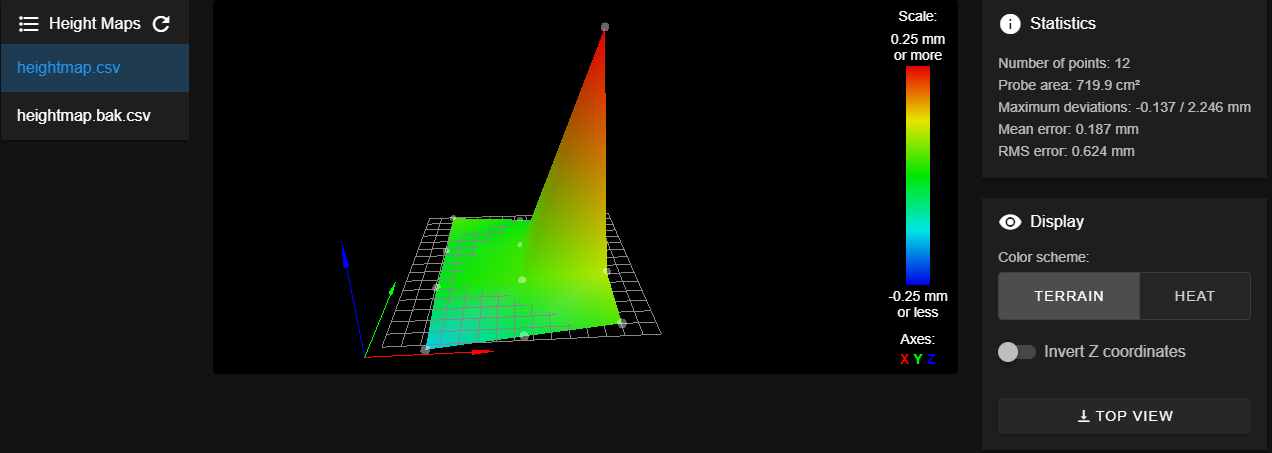
So not sure what direction to go from here. I know my probe is good, but the results of the mesh compensation isn't.
-
@gamefanatic3d is your printer a tool changer with a z probe switch on the head like the E3D one?
Could simply be that the weight of the tools when printing is causing the gantry to sag which won't be measured when you probe -
@engikeneer
Yes, I'm using the tool plates setup from E3D and the BLTouch. The BLTouch is on the opposite side of the rail from the tool head. If the weight were to make a difference it would slightly fall to the side of the tool which would naturally bring it closer to the bed, but I'm experiencing results further. The BLTouch would move away due to the twisting action, but I never measure with a Tool on since there is never enough clearance. I had thought about this, but the issue is that I can repeatably measure the distance from the bed to the nozzle compared to what DuetWeb / PanelDue is reporting. In either case, I designed my tools such that the weight of the motor was supported by the tool carriage and was nearly evenly distributed across the rail for just this reasoning.I wrote a macro to perform a G30 twice at each spot and calculate the difference from the trigger height and move down the bed after getting an accurate read of the two dives within 0.005. I disabled mesh compensation and went through a full manual bed leveling last night using just my probe to measure the distances and came up with slightly different values than when the mesh compensation routine ran, but the end result was approximately the same.
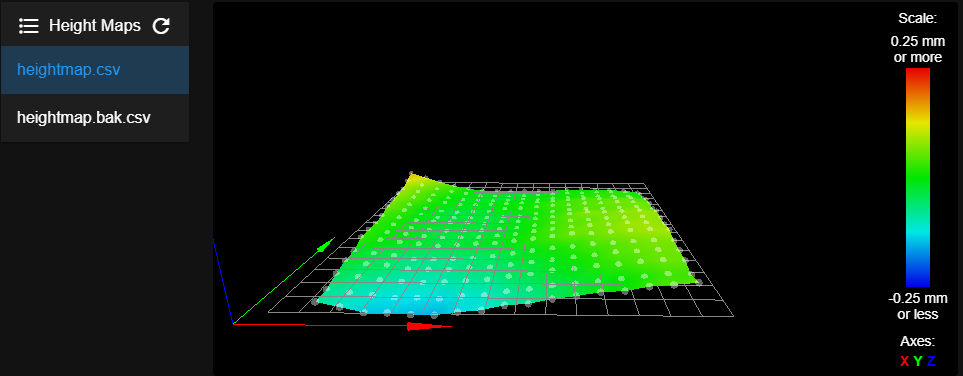
However, much along the lines of what you have suggested here, I baby stepped -0.16 when running my test and got T0 to accurately lay down the first layer. I'm not sure why this is the case and I haven't tested against T1 as of yet.
-
@fcwilt said in Mesh compensation results backwards:
I would think that if there was some sort of firmware issue that caused the reversal someone would have noticed it by now.
That's the point, this is by far not the first thread reporting such issues with toolchangers... At least two other people (me being one of them) have similar issues... Troubleshooting has so far not been any useful...
-
@gamefanatic3d Can you show how a typical first layer comes out for you? Just some cube or so. I have similar issues with my toolchanger and haven't been able to diagnose the cause yet...
-
@gamefanatic3d said in Mesh compensation results backwards:
However, much along the lines of what you have suggested here, I baby stepped -0.16 when running my test and got T0 to accurately lay down the first layer. I'm not sure why this is the case and I haven't tested against T1 as of yet.
What happens if you do this:
- disable mesh compensation
- set the Z=0 datum at a XY point on the bed where the height map suggests it is quite flat
- move tool 0 to that XY point
- move tool 0 to Z=0
- does the nozzle is just touch the bed?
- move tool 1 to that XY point
- move tool 1 to Z=0
- does the nozzle is just touch the bed?
Frederick
-
I hadn't been taking pictures of the results but set up a simple single-lined box to test a run of making the first layer and not waste too much filament.
Calibration-Bed-Level-Single-Extrusion-Boxes.stl
With one of the heightmaps that were generated by the system. You will notice is the image below a lot of areas where the single extrusion lines are missing. This is a result of not getting close enough from what I can tell and as I watched it extrude it would just gather on the nozzle in most cases. Even better, when it actually got something to stick, the slicer thought it best to go back over that line, and low and behold the nozzle would scoop it back up again due to it not barely touching. Here is the result of one such test:
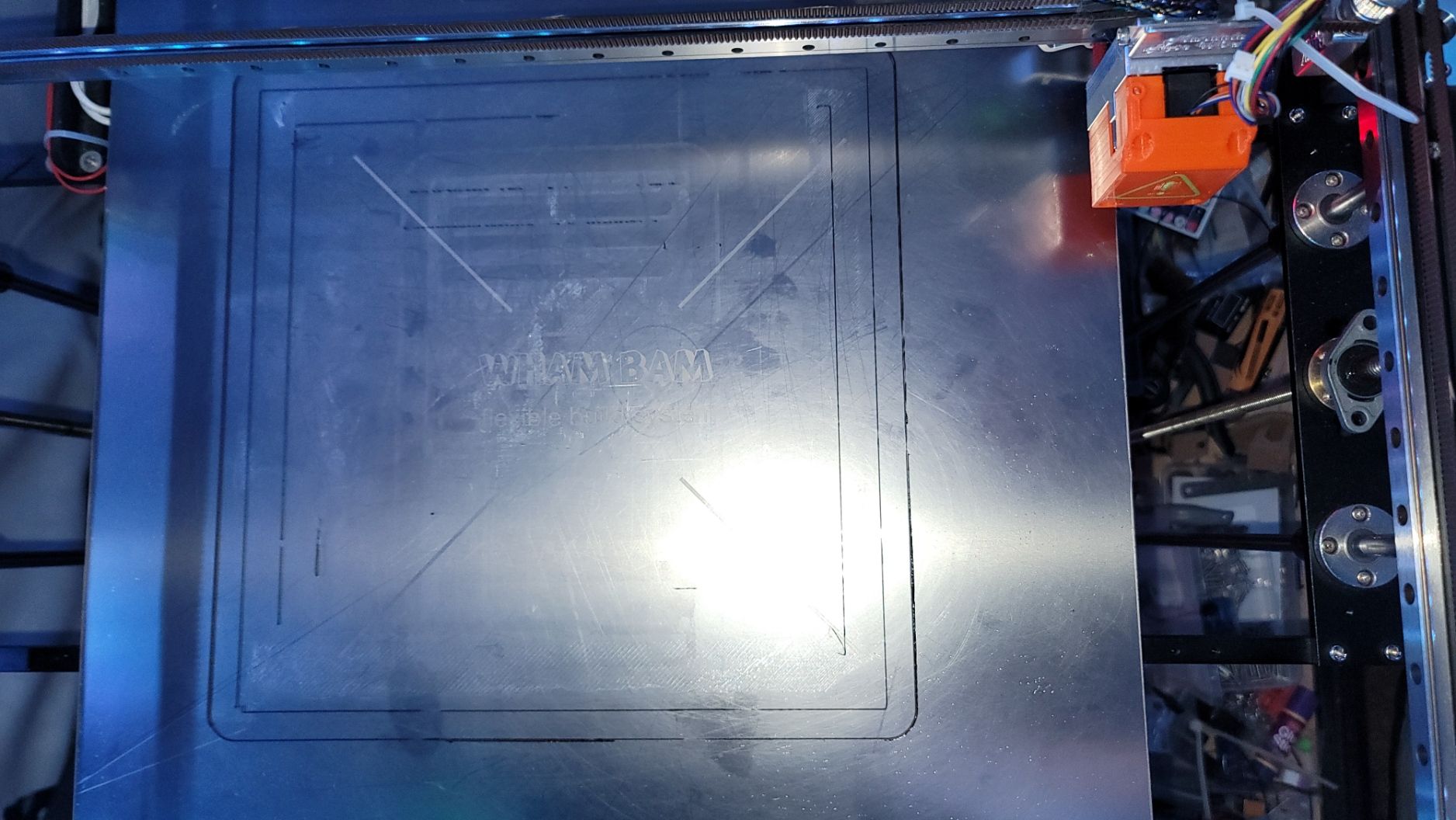
Even after running through my own macro to get the deviations in the bed, I had problems. Now I'm in the process of doing the following:
- Warm the bed and Nozzle to operating temps (Bed: 70°C, Nozzle: 230°C).
- Run G28
- Disable mesh compensation
- Using a feeler gauge manually measure the height of T0 to the bed at my typical 0 location (X200 Y200).
- Move the nozzle to the point on the bed that would normally be measured by the probe and lower it until it just barely touches my feeler gauge.
- Write down the difference in the coordinate on my custom heightmap (feeler gauge is 0.8mm) <feeler gauge height> - <Duet reported Z> = <heightmap value>
Maybe I should have done a smaller height map, but I didn't. It was 3 am and wasn't thinking clearly. I got through the first 3 furthest most Y-Axis rows. I uploaded my slightly modified map and enabled mesh compensation and measured both tools to the feeler gauge at both X200 Y200 and at least one of the points on the map and got approximately a 0 gap. So the method appears to be working, but have a ways to go.
In this image, you can see the right side (bottom of the picture) has a greatly improved first layer. This was using the heightmap I generated using my macro as the basis.

Going forward I need to find my Z-probe tool to make this an easier task and less burning of skin!
-
Just remember that when checking the Z=0 position of your tools it needs to be done at the same XY point you used for setting the Z=0 datum, otherwise bed unevenness may affect the reading.
And mesh compensation should be disabled.
Frederick
-
@fcwilt
I ran a similar test to what you were asking, I think.I turned off mesh compensation and measured at my typical 0 (X200, Y200) location with a feeler gauge (0.8mm) and then moved to a spot that was lower and found that I needed to move the head down. The results were very different from what was recorded either by my manual mesh macro attempts or the systems.
I believe the deviation the probe is finding is accurate, but for some reason is not being applied properly when the tool is engaged and thus having a larger than a normal gap. Not sure about this quite yet.